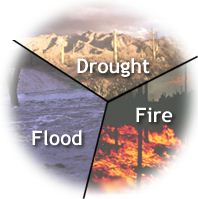

 |
 Rogue's
Gallery of Natural Disasters Rogue's
Gallery of Natural Disasters"Droughts! Floods! Fires!" Headlines shout the news of one natural disaster after another as thousands of lives are lost, buildings and homes are destroyed, and Earth's surface is drastically altered. Experts claim that the number of natural disasters each year is on the rise. According to Reliefweb, a United Nations project, over 70 natural disasters occurred worldwide during 1997. How does that number compare to past years? How does that number compare to data for the current year? Photos: Courtesy of www.arttoday.com (Drought & Flood) and Dr. David L. Adams, Professor of Forest Resources, University of Idaho, Moscow, Idaho (Fire). At left is a gallery of natural disasters that appear to be on the increase and are thought to be caused by a general rise in atmospheric temperature. As you look at the exhibits in the gallery, consider whether current data support the notion of
What constitutes a natural disaster? If a hurricane hits a city, we consider it a natural disaster, but is it a disaster if a hurricane hits an uninhabited island?
[Rogue's Gallery of Natural Disasters] [Drought
Gallery] [Fire Gallery] [ Home ] [ Teacher Pages ] [ Modules & Activities ] |
HTML code by Chris Kreger
Maintained by ETE Team
Last updated November 10, 2004
Some images © 2004 www.clipart.com
Privacy Statement and Copyright © 1997-2004 by Wheeling Jesuit University/NASA-supported Classroom of the Future. All rights reserved.
Center for Educational Technologies, Circuit Board/Apple graphic logo, and COTF Classroom of the Future logo are registered trademarks of Wheeling Jesuit University.